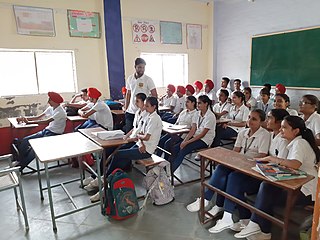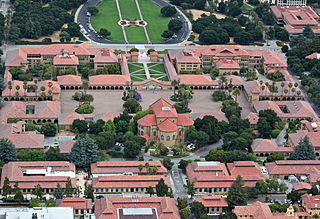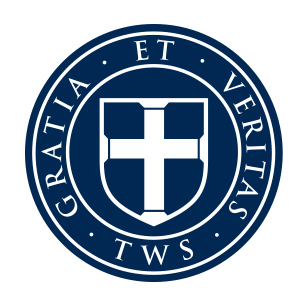
Phonics is a method for teaching reading and writing to beginners. To use phonics is to teach the relationship between the sounds of the spoken language (phonemes), and the letters (graphemes) or groups of letters or syllables of the written language. Phonics is also known as the alphabetic principle or the alphabetic code. It can be used with any writing system that is alphabetic, such as that of English, Russian, and most other languages. Phonics is also sometimes used as part of the process of teaching Chinese people to read and write Chinese characters, which are not alphabetic, using pinyin, which is.
K–12, from kindergarten to 12th grade, is an English language expression that indicates the range of years of publicly supported primary and secondary education found in the United States and Canada, which is similar to publicly supported school grades before tertiary education in several other countries, such as Afghanistan, Australia, Canada, China, Ecuador, Egypt, India, Iran, the Philippines, South Korea, and Turkey. K–12 refers to the American system which affords authority to local intersectional "districts" which may be specific to a municipality, county, or several regions, depending on population and proximity.

Education in India is primarily managed by the state-run public education system, which falls under the command of the government at three levels: central, state and local. Under various articles of the Indian Constitution and the Right of Children to Free and Compulsory Education Act, 2009, free and compulsory education is provided as a fundamental right to children aged 6 to 14. The approximate ratio of the total number of public schools to private schools in India is 10:3.

A state school or public school is a primary or secondary school that educates all students without charge. Such schools are funded in whole or in part by taxation.

A diorama is a replica of a scene, typically a three-dimensional full-size or miniature model, sometimes enclosed in a glass showcase for a museum. Dioramas are often built by hobbyists as part of related hobbies such as military vehicle modeling, miniature figure modeling, or aircraft modeling.
Sixth grade is the sixth year of formal or compulsory education. Students in sixth grade are usually 11-12 years old. It is commonly the first or second grade of middle school or the last grade of elementary school, and the sixth school year since kindergarten.
Ninth grade is the ninth or tenth year of formal or compulsory education in some countries. It is generally part of middle school or secondary school depending on country. Students in ninth grade are usually 14–15 years old, but in some countries are 15–16.

The Waverly School is a nonsectarian, coeducational, college preparatory, progressive day school in Pasadena, California, United States for students in preschool through high school. It has three campuses, and a one-acre organic farm within walking distance. It is an independent school.

Mirman School is an independent, co-educational school for highly gifted children located at 16180 Mulholland Drive in Bel-Air, Los Angeles, California, United States, with 330 pupils aged 5 to 14. Mirman School is accredited by the California Association of Independent Schools (CAIS) and the Western Association of Schools and Colleges WASC for grades K-8. Mirman is one of a handful of schools for the highly gifted in the United States.

The California Department of Education is an agency within the Government of California that oversees public education.
Education in the Philippines is compulsory at the basic education level, composed of kindergarten, elementary school, junior high school, and senior high school. The educational system is managed by three government agencies by level of education: the Department of Education (DepEd) for basic education; the Commission on Higher Education (CHED) for higher education; and the Technical Education and Skills Development Authority (TESDA) for technical and vocational education. Public education is funded by the national government.
Burlingame School District is a public school district in Burlingame, California, in the San Francisco Bay Area. Its schools serve students in kindergarten through 8th grade. It oversees 7 schools.

The educational system in California consists of public, NPS, and private schools in the U.S. state of California, including the public University of California, California State University, and California Community Colleges systems, private colleges and universities, and elementary, middle, and high schools.
Education in Peru is under the jurisdiction of the Ministry of Education, which oversees formulating, implementing and supervising the national educational policy. According to the Constitution of Peru, education is compulsory and free in public schools for the initial, primary and secondary levels. It is also free in public universities for students who are unable to pay tuition and have an adequate academic performance.
Project SEED is a mathematics education program which worked in urban school districts across the United States. Project SEED is a nonprofit organization that worked in partnership with school districts, universities, foundations, and corporations to teach advanced mathematics to elementary and middle school students as a supplement to their regular math instruction. Project SEED also provides professional development for classroom teachers. Founded in 1963 by William F. Johntz, its primary goal is to use mathematics to increase the educational options of low-achieving, at-risk students.

Rolling Hills Country Day School is a nonsectarian independent Kindergarten to Grade 8 school located in Rolling Hills Estates on the Palos Verdes Peninsula in Los Angeles County, California. The school is a for-profit school, owned by the school administration, the director and vice principal hold majority shares.

The Wilberforce School is a private, classical Christian school in Princeton, New Jersey, serving students in kindergarten through twelfth grade. Founded in 2005, the school is named in honor of abolitionist William Wilberforce. The Head of School is Howe Whitman and the Academic Dean is Karen Ristuccia.

Natchaug Elementary School is a public elementary school in Willimantic, Connecticut, United States. The school opened in 1865 at the junction of Milk Street and Jackson Street, in downtown Willimantic. It is part of the Windham Public School system and one of four elementary schools and a K-8 STEM magnet school. Natchaug is accredited by the New England Association of Schools and Colleges. The name Natchaug comes from the Nipmuc word meaning "land between the rivers." The school colors are bright green and blue.

High school or senior high school is the education students receive in the final stage of secondary education in the United States. In the United States most high schoolers are ages 14-18 but some ages could be delayed due to birthdays. Most comparable to secondary schools, high schools generally deliver phase three of the ISCED model of education. High schools have subject-based classes. The name high school is applied in other countries, but no universal generalization can be made as to the age range, financial status, or ability level of the pupils accepted. In North America, most high schools include grades 9 through 12. Students attend them following graduation from middle school.
The following is a list of bilingual education by country or region.













